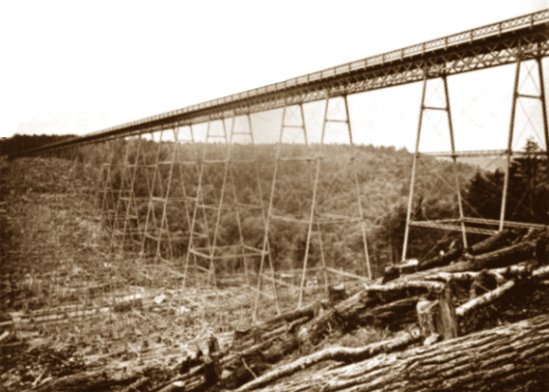The Kinzua Viaduct
Today, a story of railroads and airplanes. The University of Houston's College of Engineering presents this series about the machines that make our civilization run, and the people whose ingenuity created them.
On July 21st, 2003, a tornado touched down in north-central Pennsylvania destroying most of the Kinzua Viaduct; and therein hangs a tale:
Buffalo, New York, had been in dire need of more coal in 1881. Demand had reached three million tons per year; and the Lake Erie & Western Railroad saw a chance to turn a big profit by shipping coal in from the Pennsylvania fields, due south of Buffalo.
The brilliant engineer Octave Chanute decided it'd be cheaper to bridge the Kinzua Valley than to build the railroad around it. You and I know Chanute today, not for his work on railways, but for pioneering the airplane. Chanute did important early glider experiments and he collaborated with the Wright Brothers.
But this was earlier. Chanute boldly let a contract for a heroic viaduct across the valley. It was built of steel set on stone footings. It was over three hundred feet high and over two thousand feet long. When it was finished, people came in from miles away to see it. They paid a dollar for a rail excursion across it. For a season, this was the eighth wonder of the world.
High winds through the valley were a constant threat. The viaduct swayed in the wind, and trains had to slow to five miles an hour. Finally, in 1900, Chanute collaborated on the design of a new structure, with heavier, stiffer members. That version served until 1959. The out-of-service bridge eventually became the centerpiece of Pennsylvania's Kinzua Bridge State Park. Sunday visitors picnicked there, and they walked on the bridge.
Inspectors found serious deterioration in 2002, and plans were being made to renovate the old viaduct. The tornado ended that. Now all that stands is a section on one end. But the bridge commanded such enormous public affection and attention that people are talking about rebuilding it. Is that foolishness?
Maybe not. We don't blink when people reconstruct, say, Fort Clatsop where Lewis and Clark camped at the mouth of the Columbia, or Williamsburg, once the seat of the Virginia Colony. And the railroads are an essential element of the American saga, just as surely as Lewis and Clark or the Virginia Colony. That's why the viaduct always drew people like a magnet.
The saga of the Kinzua Viaduct has another dimension of poignancy for me, however. It was destroyed just a century after its designer, Octave Chanute, had been deeply involved in comparing experiments and data with the Wright Brothers. For me, this glorious railroad bridge, once soaring across the Kinzua Valley, represents the end of the old century and the beginning of the new.
I cannot look at it without thinking about that remarkable engineer. Chanute was the rare person who managed to live in both centuries -- who made the seemingly impossible leap from rail to flight, from steel to bamboo, from the old world to the new.
I'm John Lienhard, at the University of Houston, where we're interested in the way inventive minds work.
(Theme music)
K. Jaeger, Death of a Landmark: A Tornado Does What a Century of Hard Use Could Not. Invention and Technology, Winter 2004, pp. 10-11.
For a fine history of the bridge and many illustrations, see: http://www.smethporthistory.org/kinzuaviaduct/

The original Kinzua Viaduct
(From an album of designs of the Phoenix Bridge Company)